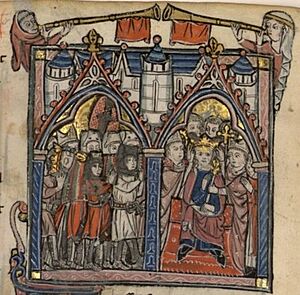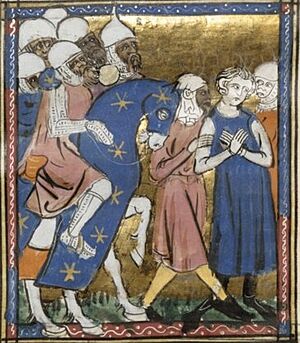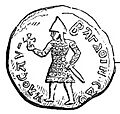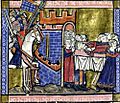Baldwin II of Jerusalem facts for kids
Quick facts for kids Baldwin II |
|
|---|---|
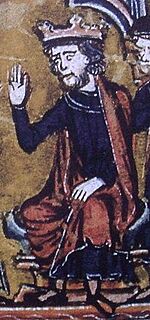 |
|
| King of Jerusalem | |
| Reign | 2 April 1118 – 21 August 1131 |
| Coronation | 25 December 1119 |
| Predecessor | Baldwin I |
| Successors | Fulk and Melisende |
| Count of Edessa | |
| Reign | 1100–1118 |
| Predecessor | Baldwin I |
| Successor | Joscelin I |
| Born | c. 1075 Rethel, Kingdom of France |
| Died | 21 August 1131 (aged c. 56) Jerusalem, Kingdom of Jerusalem |
| Burial | Church of the Holy Sepulchre, Jerusalem |
| Spouse | Morphia of Melitene |
| Issue |
|
| House | House of Rethel |
| Father | Hugh I, Count of Rethel |
| Mother | Melisende of Montlhéry |
Baldwin II, also known as Baldwin of Bourcq (born around 1075 – died August 21, 1131), was an important leader during the time of the Crusades. He was the Count of Edessa from 1100 to 1118 and then became the King of Jerusalem from 1118 until his death.
Baldwin traveled to the Holy Land with his cousins, Godfrey of Bouillon and Baldwin of Boulogne, during the First Crusade. When Baldwin of Boulogne left Edessa to become King of Jerusalem, Baldwin II took over as the second Count of Edessa. He faced many challenges, including being captured twice by Muslim leaders. Despite these difficulties, he was known for his military skills and his efforts to protect and expand the Crusader states.
Contents
Baldwin's Early Life
Baldwin's exact birth year isn't known, but he was born around 1075. His father was Count Hugh I of Rethel. Baldwin was the lord of a place called Bourcq when he joined his relative, Godfrey of Bouillon, at the start of the First Crusade. The Crusader army left for the Holy Land in August 1096.
In January 1097, Baldwin was chosen to represent Godfrey of Bouillon at a meeting with the Byzantine emperor, Alexios I Komnenos. Later, Baldwin joined his cousin, Baldwin of Boulogne, and Tancred, as they explored new lands. They captured several towns, including Edessa, where Baldwin of Boulogne created the first crusader state, the County of Edessa, in 1098.
Baldwin later rejoined the main Crusader army as it marched towards Jerusalem. He helped capture Bethlehem and was part of the siege that led to the city's fall in July 1099. After Jerusalem was captured, Baldwin stayed in Syria.
Becoming Count of Edessa
When Baldwin of Boulogne decided to leave Edessa to become King of Jerusalem, he chose Baldwin II to take his place as Count of Edessa. Baldwin II officially became Count on October 2, 1100.
First Years as Count
To strengthen his rule, Baldwin married Morphia, the daughter of Gabriel, an Armenian lord. Most of the people in Edessa were Armenian, so this marriage helped him connect with them.
Baldwin faced early challenges. In 1101, a ruler named Sökmen attacked Saruj. Baldwin tried to defend the town but was defeated. He later returned with new troops and forced Sökmen to leave.
In 1102, Baldwin's cousin, Joscelin of Courtenay, came to Edessa, and Baldwin gave him lands to the west of the Euphrates River. Baldwin also helped the King of Jerusalem fight against Egyptian invaders.
Baldwin's First Capture
In May 1104, Baldwin's troops were raiding lands near Harran. Two Muslim leaders, Sökmen and Jikirmish, formed an alliance and attacked Edessa. Baldwin, along with Joscelin and Bohemond, tried to fight them.
During the Battle of Harran on May 7, 1104, the Muslim forces used a trick called a feigned retreat to draw the Crusaders into a trap. Baldwin and Joscelin were captured. Baldwin was first held by Sökmen, then by Jikirmish, and later by another leader named Jawali Saqawa. While Baldwin was a prisoner, Tancred ruled Edessa for him.
Joscelin was released in 1107, and he began working to free Baldwin. In the summer of 1108, Baldwin was finally released after a large ransom was paid and Joscelin offered himself as a hostage.
Challenges and Alliances
After his release, Baldwin returned to Edessa. However, Tancred, who had been ruling Edessa, didn't want to give it back easily. They had disagreements, but eventually, other Crusader leaders helped them make peace. Baldwin returned to Edessa in September 1108.
Baldwin then made an alliance with Jawali, who had released him. This alliance worried other Muslim rulers, like Radwan of Aleppo, who then allied with Tancred. Baldwin and Joscelin fought alongside Jawali against Radwan and Tancred, but they were defeated.
To stop these conflicts among Crusader leaders, Baldwin I of Jerusalem called a meeting in April 1109. At this meeting, peace was made between Baldwin and Tancred. Baldwin's rule over Edessa was confirmed.
Battles with Mawdud
In April 1110, a powerful Muslim leader named Mawdud from Mosul attacked Edessa. Baldwin asked King Baldwin I of Jerusalem for help. The King and other Crusader leaders came to Edessa, forcing Mawdud to retreat.
Mawdud launched more attacks in the following years. In 1111, he besieged Turbessel, a town in Edessa. Crusader leaders, including Baldwin, united their forces, and Mawdud eventually withdrew. In 1112, Mawdud again besieged Edessa but couldn't capture it. He was later murdered in 1113.
These invasions caused a lot of damage to the eastern parts of Edessa. In 1113, Baldwin had a disagreement with Joscelin, who had a very prosperous area in Turbessel. Baldwin briefly imprisoned Joscelin until he gave up Turbessel. Joscelin then moved to Jerusalem.
Expanding His Lands
After Mawdud's invasions, Baldwin worked to strengthen his county. He took advantage of weaker Muslim powers to expand his territory. He captured several Armenian lordships, including Raban, Kaisun, and Birejik, in 1116 and 1117. This helped Baldwin control more land along the Euphrates River.
Becoming King of Jerusalem
King Baldwin I of Jerusalem died on April 2, 1118. He had said that his brother, Eustace III, should become king. But if Eustace couldn't come, then Baldwin of Bourcq (Baldwin II) should be chosen.
The leaders in Jerusalem debated who should be king. The Patriarch of Jerusalem, Arnulf of Chocques, and Joscelin of Courtenay argued that Baldwin II should be elected quickly to avoid any problems. So, on April 14, Baldwin was chosen as the new king. His coronation was later held on Christmas Day.
Baldwin promised the County of Edessa to Joscelin. He also took direct control of several important towns in the kingdom, like Nablus, Jaffa, and Acre. He reorganized the royal court, appointing new officials.
Eustace III, who was in Europe, decided not to come to Jerusalem after learning that Baldwin had already been crowned king.
Facing Muslim Armies
Baldwin II quickly faced new threats. In 1118, Egypt and Damascus formed an alliance. Baldwin went to the southern border to defend against the Egyptians and asked for help from Antioch and Tripoli. No major battles happened, and the armies eventually left.
In May 1119, Muslim leaders like Ilghazi and Toghtekin began raiding Antioch and Edessa. Baldwin rushed north to help. However, the Prince of Antioch, Roger, attacked without waiting for Baldwin. On June 28, 1119, Roger's army was almost completely destroyed in the Battle of the "Field of Blood". Roger and many of his soldiers died.
Baldwin and Pons of Tripoli arrived in Antioch shortly after. Since the young Prince Bohemond II was still in Italy, Baldwin was chosen to rule Antioch as a regent (a temporary ruler). He then led the Crusader forces against Ilghazi and Toghtekin. In August 1119, they fought the Battle of Hab. While both sides claimed victory, Baldwin was welcomed back to Antioch as a hero. Before leaving Antioch, he officially gave the County of Edessa to Joscelin of Courtenay.
In January 1120, Baldwin and the Patriarch held an important meeting called the Council of Nablus. They made new laws for the kingdom, including rules about collecting taxes for the church and penalties for crimes. This was a big step in creating a legal system for Jerusalem.
At this council, a group of knights who wanted to protect pilgrims, known as the Knights Templar, were officially recognized. Baldwin gave them a place to stay on the Temple Mount.
Baldwin continued to lead campaigns against Muslim forces in the north. He signed a truce with Ilghazi in 1120 and later forced Ilghazi's son to give back several forts to the Crusaders.
In 1122, Baldwin resolved a dispute with Pons of Tripoli. He also helped Joscelin of Edessa when he was attacked by Muslim forces. However, in September 1122, Joscelin was captured. Ilghazi died in November 1122, and Baldwin managed to get some captured forts back.
Baldwin's Second Capture
In April 1123, while Baldwin was on a military raid, he was ambushed and captured by Belek Ghazi. Baldwin was taken to a fortress. Later, Joscelin's Armenian supporters managed to take control of the fortress where Baldwin was held. Joscelin left to gather more troops, but Baldwin stayed behind with the Armenian soldiers. Belek returned, forced Baldwin to surrender, and moved him to another prison.
During Baldwin's absence, the leaders in Jerusalem chose Eustace Grenier to rule as regent. After Grenier died, William of Bures took over. These regents worked closely with the Patriarch to manage the kingdom. They made an important agreement with the Venetians, offering them trade benefits in exchange for their help. With Venetian ships, the Crusaders successfully captured the important city of Tyre in July 1124.
Some nobles in Jerusalem were unhappy with Baldwin's rule and even tried to offer the crown to Charles the Good, the Count of Flanders, but Charles refused.
Belek Ghazi died in May 1124, and Baldwin became a prisoner of Timurtash. Negotiations for Baldwin's release began. An agreement was reached: Baldwin would pay a large ransom and give up some forts. After part of the ransom was paid and some hostages (including Baldwin's youngest daughter, Ioveta) were given, Baldwin was released on August 29, 1124.
More Battles and Victories
After his release, Baldwin went to Antioch. He had promised to give up some Antiochene lands as part of his ransom, but the Patriarch of Antioch told him he wasn't allowed to do that.
In October 1124, Baldwin besieged Aleppo. However, a large Muslim army led by Aqsunqur al-Bursuqi approached, forcing Baldwin to abandon the siege in January 1125.
Baldwin returned to Jerusalem in April 1125. He renegotiated the agreement with the Venetians, ensuring they would continue to help the kingdom militarily. In May 1125, Baldwin, along with Pons of Tripoli and Joscelin of Edessa, defeated a large Seljuq army at the Battle of Azaz. This victory was very important and allowed Baldwin to pay off his ransom.
Baldwin continued to lead military campaigns, including raids against Damascus. In 1126, he defeated Toghtekin and captured the town of Rafniye.
Who Would Rule Next?
In October 1126, Bohemond II of Antioch arrived in Syria to take control of Antioch, ending Baldwin's regency there. Bohemond married Baldwin's second daughter, Alice. Since Baldwin had no sons, he named his eldest daughter, Melisende, as his heir in 1126 or 1127.
Baldwin realized that the Crusaders needed more help from Europe to conquer Damascus. So, in 1127, he sent envoys to France to offer Melisende's hand in marriage to Fulk V of Anjou, a powerful count.
Fulk of Anjou arrived in the Holy Land in the spring of 1129 and married Melisende. Baldwin gave them control of two wealthy towns, Tyre and Acre. New Crusaders also arrived, strengthening the kingdom.
In September 1129, Baldwin made an alliance with a group called the Nizari (also known as Assassins) in Damascus. They offered him the fortress of Banias in exchange for safety. Baldwin accepted and captured Banias. He then launched an attack on Damascus, but bad weather and a strong defense forced him to retreat in December 1129.
In February 1130, Bohemond II was killed in battle. Baldwin traveled to Antioch to arrange for the rule of the principality. His daughter Alice tried to take control as regent for her young daughter, Constance, but the Antiochene nobles supported Baldwin. He entered Antioch, forgave Alice, and appointed Joscelin of Edessa to govern Antioch for Constance.
Baldwin became seriously ill after returning from Antioch. In August 1131, he made arrangements for his succession, naming Fulk, Melisende, and their infant son, Baldwin, as his heirs. He died on August 21, 1131, and was buried in the Church of the Holy Sepulchre.
Baldwin's Family
Baldwin's wife, Morphia, was from an Orthodox Christian noble family. Her father, Gabriel, arranged her marriage to Baldwin to gain Crusader support. Morphia and Baldwin had four daughters:
- Melisende, Queen of Jerusalem: The eldest, who became Queen of Jerusalem with her husband Fulk.
- Alice: Their second daughter, who married Bohemond II of Antioch.
- Hodierna: Their third daughter, who married Raymond II, Count of Tripoli.
- Ioveta: Their youngest daughter, who became a nun and later an abbess.
What People Thought of Baldwin
Baldwin was a respected military leader. William of Tyre, a historian, described him as "a devout and God-fearing man, notable for his loyalty and for his great experience in military matters." He was sometimes called "the Thorny" because of his strong will.
However, some people criticized him. The Armenian historian Matthew of Edessa said Baldwin had "an intolerable love for money." Another historian, Fulcher of Chartres, suggested that Baldwin's capture might have been a punishment for his sins. Despite these criticisms, an Arab historian, Ibn al-Qalanisi, noted that after Baldwin, there was no one left among the Crusaders with such good judgment and ability to govern.
Images for kids
See also
 In Spanish: Balduino II de Jerusalén para niños
In Spanish: Balduino II de Jerusalén para niños


